Business and Marketing Analysis: KitKat Case Study and Five Forces
VerifiedAdded on 2020/04/15
|7
|1324
|1203
Report
AI Summary
This report provides a comprehensive analysis of the KitKat brand, focusing on its market position and competitive environment within the UK food industry. Employing Porter's Five Forces model, the report examines the bargaining power of suppliers and buyers, threats of substitute products and new entrants, and the intensity of competitive rivalry. The analysis highlights Nestle's strong brand image and its ability to navigate market challenges. The report also discusses KitKat's strategies to maintain its market share, including focusing on customer needs, health aspects, and long-term supplier relationships. The conclusion summarizes the key findings, emphasizing KitKat's competitive position and the importance of adapting to market dynamics. The report includes a list of references supporting the analysis.

Running Head: KitKat Case 1
Paraphrase This Document
Need a fresh take? Get an instant paraphrase of this document with our AI Paraphraser
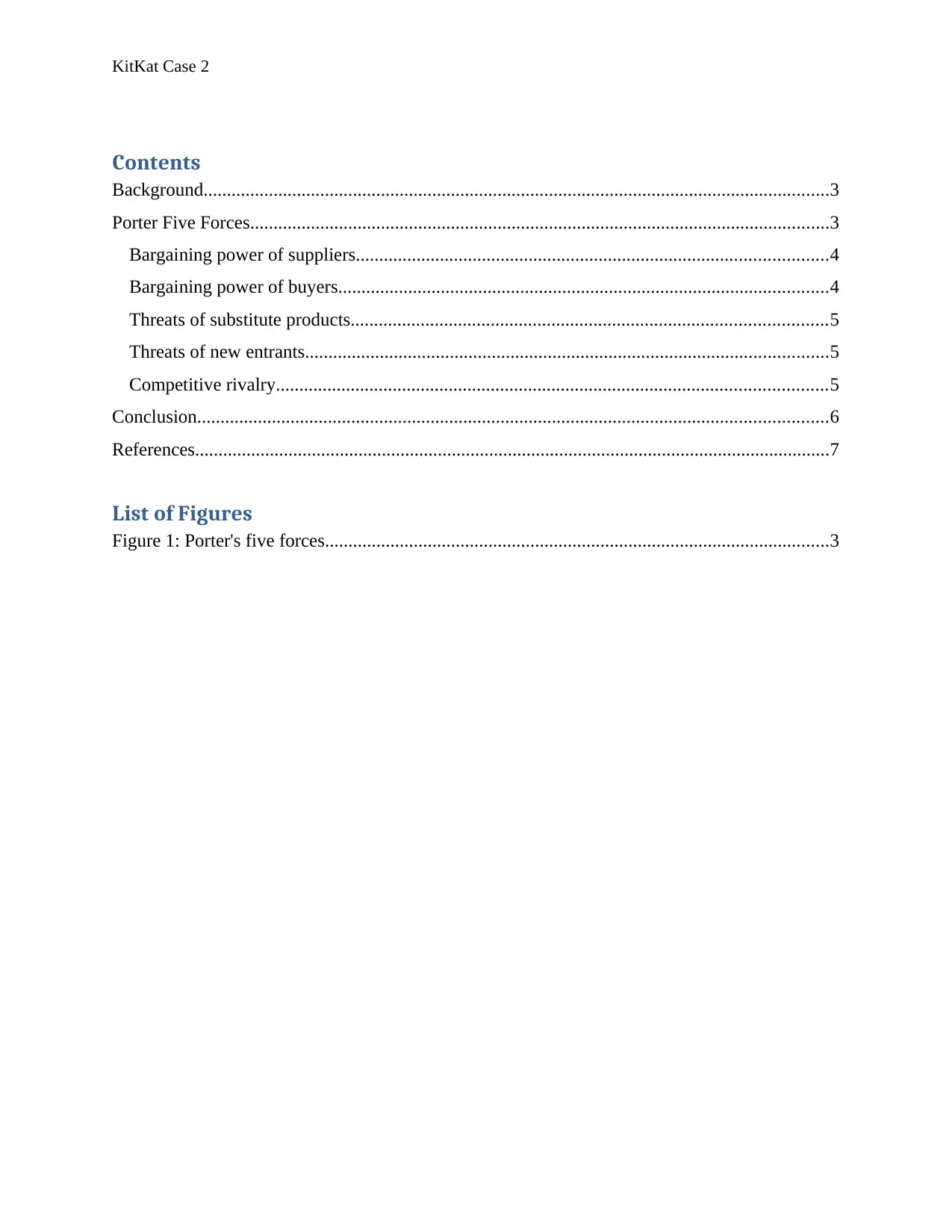
KitKat Case 2
Contents
Background......................................................................................................................................3
Porter Five Forces............................................................................................................................3
Bargaining power of suppliers.....................................................................................................4
Bargaining power of buyers.........................................................................................................4
Threats of substitute products......................................................................................................5
Threats of new entrants................................................................................................................5
Competitive rivalry......................................................................................................................5
Conclusion.......................................................................................................................................6
References........................................................................................................................................7
List of Figures
Figure 1: Porter's five forces............................................................................................................3
Contents
Background......................................................................................................................................3
Porter Five Forces............................................................................................................................3
Bargaining power of suppliers.....................................................................................................4
Bargaining power of buyers.........................................................................................................4
Threats of substitute products......................................................................................................5
Threats of new entrants................................................................................................................5
Competitive rivalry......................................................................................................................5
Conclusion.......................................................................................................................................6
References........................................................................................................................................7
List of Figures
Figure 1: Porter's five forces............................................................................................................3
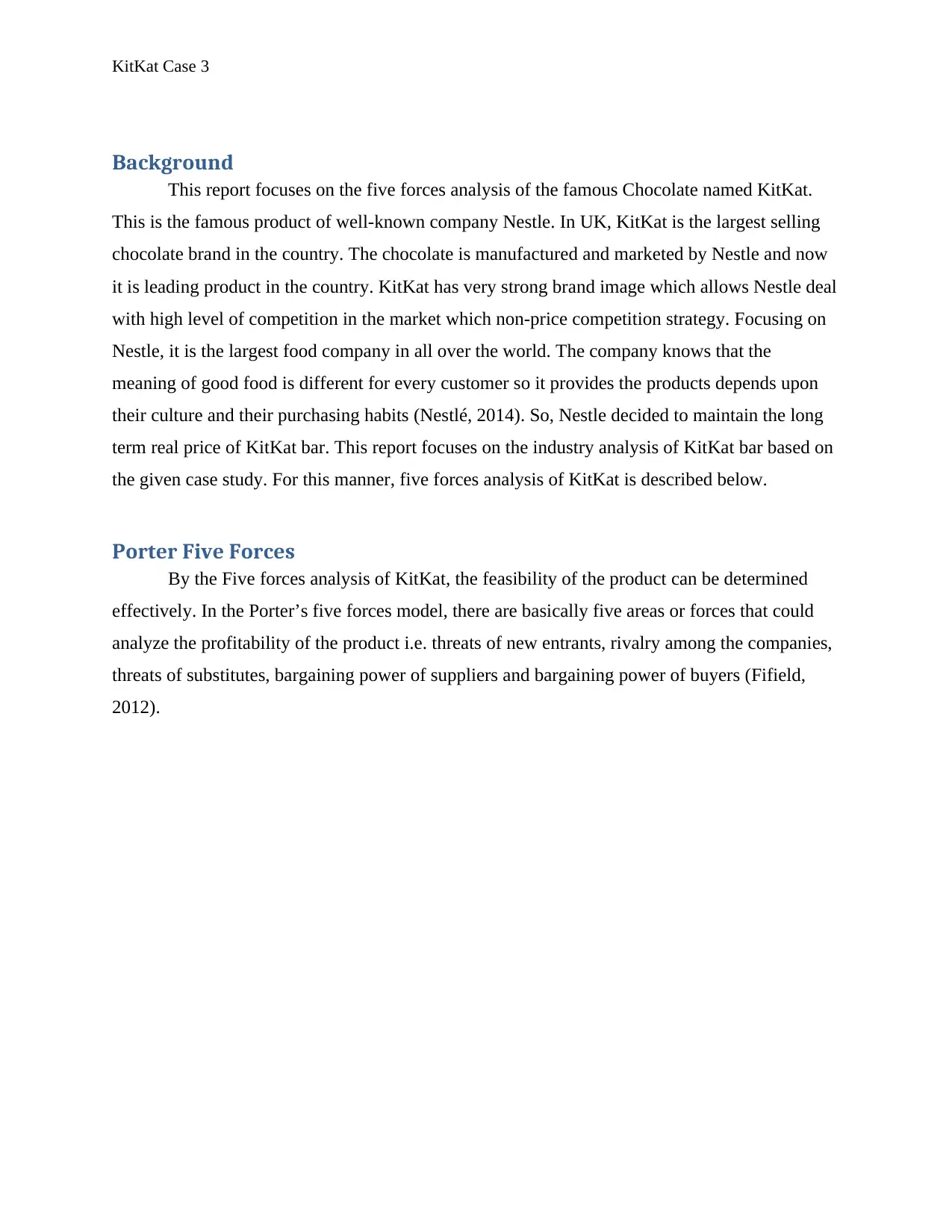
KitKat Case 3
Background
This report focuses on the five forces analysis of the famous Chocolate named KitKat.
This is the famous product of well-known company Nestle. In UK, KitKat is the largest selling
chocolate brand in the country. The chocolate is manufactured and marketed by Nestle and now
it is leading product in the country. KitKat has very strong brand image which allows Nestle deal
with high level of competition in the market which non-price competition strategy. Focusing on
Nestle, it is the largest food company in all over the world. The company knows that the
meaning of good food is different for every customer so it provides the products depends upon
their culture and their purchasing habits (Nestlé, 2014). So, Nestle decided to maintain the long
term real price of KitKat bar. This report focuses on the industry analysis of KitKat bar based on
the given case study. For this manner, five forces analysis of KitKat is described below.
Porter Five Forces
By the Five forces analysis of KitKat, the feasibility of the product can be determined
effectively. In the Porter’s five forces model, there are basically five areas or forces that could
analyze the profitability of the product i.e. threats of new entrants, rivalry among the companies,
threats of substitutes, bargaining power of suppliers and bargaining power of buyers (Fifield,
2012).
Background
This report focuses on the five forces analysis of the famous Chocolate named KitKat.
This is the famous product of well-known company Nestle. In UK, KitKat is the largest selling
chocolate brand in the country. The chocolate is manufactured and marketed by Nestle and now
it is leading product in the country. KitKat has very strong brand image which allows Nestle deal
with high level of competition in the market which non-price competition strategy. Focusing on
Nestle, it is the largest food company in all over the world. The company knows that the
meaning of good food is different for every customer so it provides the products depends upon
their culture and their purchasing habits (Nestlé, 2014). So, Nestle decided to maintain the long
term real price of KitKat bar. This report focuses on the industry analysis of KitKat bar based on
the given case study. For this manner, five forces analysis of KitKat is described below.
Porter Five Forces
By the Five forces analysis of KitKat, the feasibility of the product can be determined
effectively. In the Porter’s five forces model, there are basically five areas or forces that could
analyze the profitability of the product i.e. threats of new entrants, rivalry among the companies,
threats of substitutes, bargaining power of suppliers and bargaining power of buyers (Fifield,
2012).
⊘ This is a preview!⊘
Do you want full access?
Subscribe today to unlock all pages.

Trusted by 1+ million students worldwide
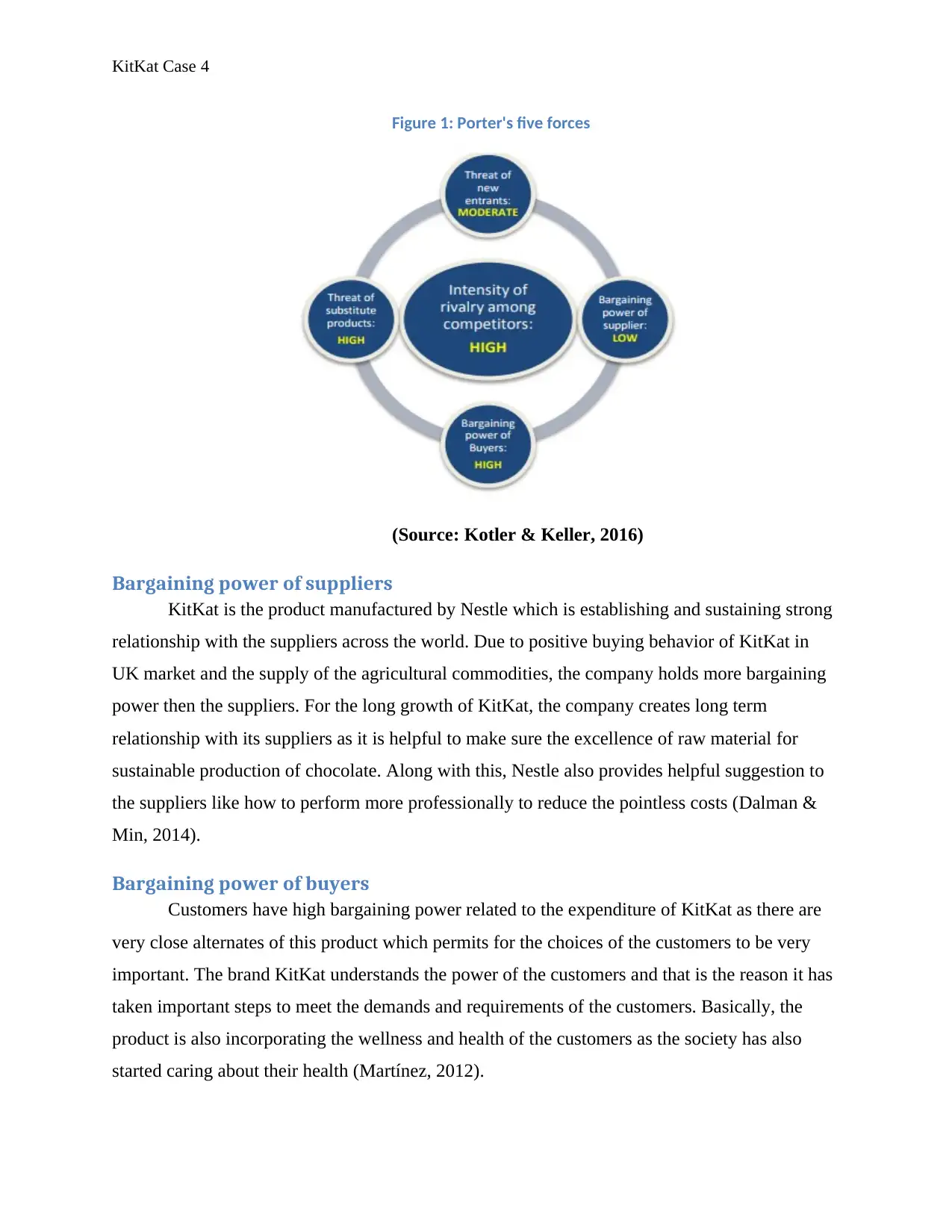
KitKat Case 4
Figure 1: Porter's five forces
(Source: Kotler & Keller, 2016)
Bargaining power of suppliers
KitKat is the product manufactured by Nestle which is establishing and sustaining strong
relationship with the suppliers across the world. Due to positive buying behavior of KitKat in
UK market and the supply of the agricultural commodities, the company holds more bargaining
power then the suppliers. For the long growth of KitKat, the company creates long term
relationship with its suppliers as it is helpful to make sure the excellence of raw material for
sustainable production of chocolate. Along with this, Nestle also provides helpful suggestion to
the suppliers like how to perform more professionally to reduce the pointless costs (Dalman &
Min, 2014).
Bargaining power of buyers
Customers have high bargaining power related to the expenditure of KitKat as there are
very close alternates of this product which permits for the choices of the customers to be very
important. The brand KitKat understands the power of the customers and that is the reason it has
taken important steps to meet the demands and requirements of the customers. Basically, the
product is also incorporating the wellness and health of the customers as the society has also
started caring about their health (Martínez, 2012).
Figure 1: Porter's five forces
(Source: Kotler & Keller, 2016)
Bargaining power of suppliers
KitKat is the product manufactured by Nestle which is establishing and sustaining strong
relationship with the suppliers across the world. Due to positive buying behavior of KitKat in
UK market and the supply of the agricultural commodities, the company holds more bargaining
power then the suppliers. For the long growth of KitKat, the company creates long term
relationship with its suppliers as it is helpful to make sure the excellence of raw material for
sustainable production of chocolate. Along with this, Nestle also provides helpful suggestion to
the suppliers like how to perform more professionally to reduce the pointless costs (Dalman &
Min, 2014).
Bargaining power of buyers
Customers have high bargaining power related to the expenditure of KitKat as there are
very close alternates of this product which permits for the choices of the customers to be very
important. The brand KitKat understands the power of the customers and that is the reason it has
taken important steps to meet the demands and requirements of the customers. Basically, the
product is also incorporating the wellness and health of the customers as the society has also
started caring about their health (Martínez, 2012).
Paraphrase This Document
Need a fresh take? Get an instant paraphrase of this document with our AI Paraphraser
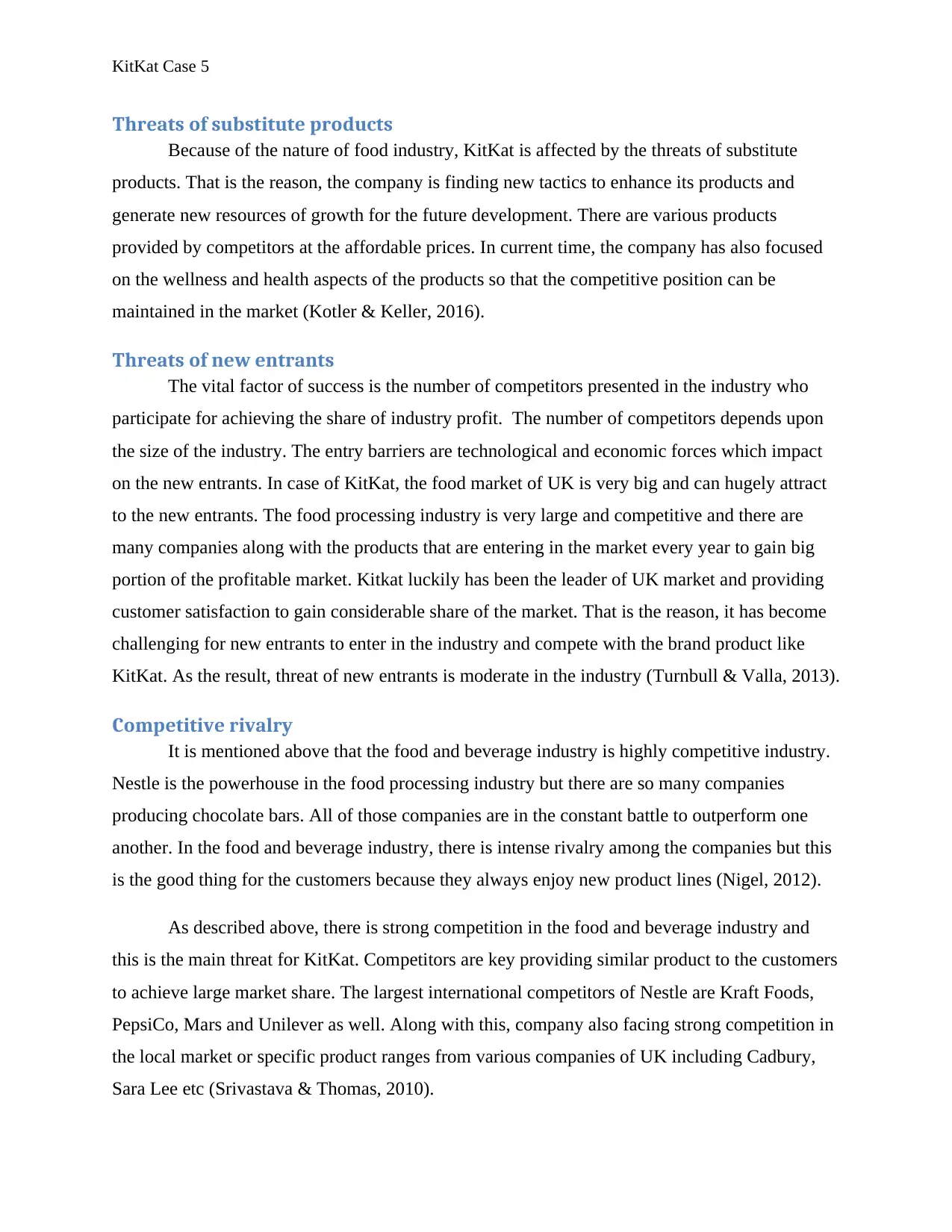
KitKat Case 5
Threats of substitute products
Because of the nature of food industry, KitKat is affected by the threats of substitute
products. That is the reason, the company is finding new tactics to enhance its products and
generate new resources of growth for the future development. There are various products
provided by competitors at the affordable prices. In current time, the company has also focused
on the wellness and health aspects of the products so that the competitive position can be
maintained in the market (Kotler & Keller, 2016).
Threats of new entrants
The vital factor of success is the number of competitors presented in the industry who
participate for achieving the share of industry profit. The number of competitors depends upon
the size of the industry. The entry barriers are technological and economic forces which impact
on the new entrants. In case of KitKat, the food market of UK is very big and can hugely attract
to the new entrants. The food processing industry is very large and competitive and there are
many companies along with the products that are entering in the market every year to gain big
portion of the profitable market. Kitkat luckily has been the leader of UK market and providing
customer satisfaction to gain considerable share of the market. That is the reason, it has become
challenging for new entrants to enter in the industry and compete with the brand product like
KitKat. As the result, threat of new entrants is moderate in the industry (Turnbull & Valla, 2013).
Competitive rivalry
It is mentioned above that the food and beverage industry is highly competitive industry.
Nestle is the powerhouse in the food processing industry but there are so many companies
producing chocolate bars. All of those companies are in the constant battle to outperform one
another. In the food and beverage industry, there is intense rivalry among the companies but this
is the good thing for the customers because they always enjoy new product lines (Nigel, 2012).
As described above, there is strong competition in the food and beverage industry and
this is the main threat for KitKat. Competitors are key providing similar product to the customers
to achieve large market share. The largest international competitors of Nestle are Kraft Foods,
PepsiCo, Mars and Unilever as well. Along with this, company also facing strong competition in
the local market or specific product ranges from various companies of UK including Cadbury,
Sara Lee etc (Srivastava & Thomas, 2010).
Threats of substitute products
Because of the nature of food industry, KitKat is affected by the threats of substitute
products. That is the reason, the company is finding new tactics to enhance its products and
generate new resources of growth for the future development. There are various products
provided by competitors at the affordable prices. In current time, the company has also focused
on the wellness and health aspects of the products so that the competitive position can be
maintained in the market (Kotler & Keller, 2016).
Threats of new entrants
The vital factor of success is the number of competitors presented in the industry who
participate for achieving the share of industry profit. The number of competitors depends upon
the size of the industry. The entry barriers are technological and economic forces which impact
on the new entrants. In case of KitKat, the food market of UK is very big and can hugely attract
to the new entrants. The food processing industry is very large and competitive and there are
many companies along with the products that are entering in the market every year to gain big
portion of the profitable market. Kitkat luckily has been the leader of UK market and providing
customer satisfaction to gain considerable share of the market. That is the reason, it has become
challenging for new entrants to enter in the industry and compete with the brand product like
KitKat. As the result, threat of new entrants is moderate in the industry (Turnbull & Valla, 2013).
Competitive rivalry
It is mentioned above that the food and beverage industry is highly competitive industry.
Nestle is the powerhouse in the food processing industry but there are so many companies
producing chocolate bars. All of those companies are in the constant battle to outperform one
another. In the food and beverage industry, there is intense rivalry among the companies but this
is the good thing for the customers because they always enjoy new product lines (Nigel, 2012).
As described above, there is strong competition in the food and beverage industry and
this is the main threat for KitKat. Competitors are key providing similar product to the customers
to achieve large market share. The largest international competitors of Nestle are Kraft Foods,
PepsiCo, Mars and Unilever as well. Along with this, company also facing strong competition in
the local market or specific product ranges from various companies of UK including Cadbury,
Sara Lee etc (Srivastava & Thomas, 2010).
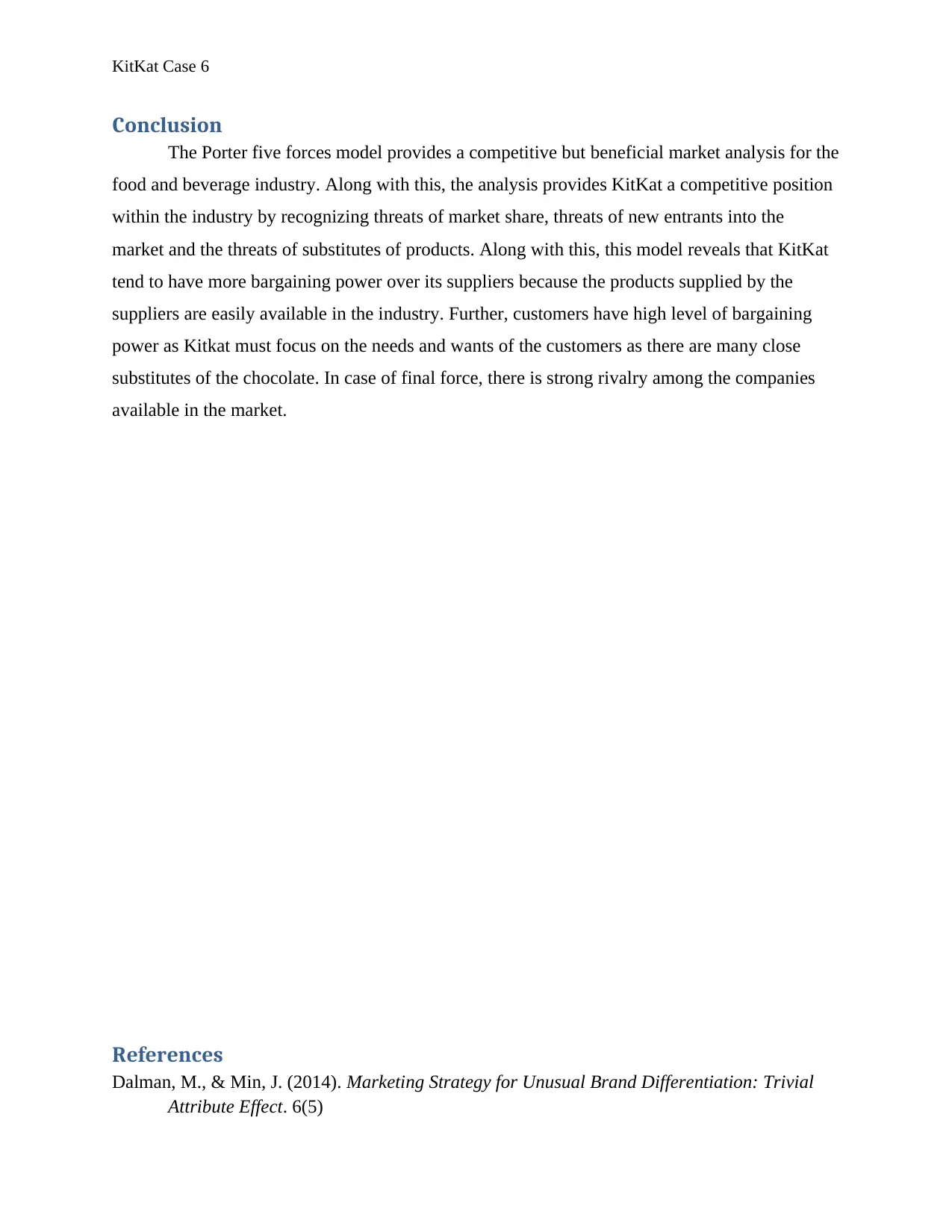
KitKat Case 6
Conclusion
The Porter five forces model provides a competitive but beneficial market analysis for the
food and beverage industry. Along with this, the analysis provides KitKat a competitive position
within the industry by recognizing threats of market share, threats of new entrants into the
market and the threats of substitutes of products. Along with this, this model reveals that KitKat
tend to have more bargaining power over its suppliers because the products supplied by the
suppliers are easily available in the industry. Further, customers have high level of bargaining
power as Kitkat must focus on the needs and wants of the customers as there are many close
substitutes of the chocolate. In case of final force, there is strong rivalry among the companies
available in the market.
References
Dalman, M., & Min, J. (2014). Marketing Strategy for Unusual Brand Differentiation: Trivial
Attribute Effect. 6(5)
Conclusion
The Porter five forces model provides a competitive but beneficial market analysis for the
food and beverage industry. Along with this, the analysis provides KitKat a competitive position
within the industry by recognizing threats of market share, threats of new entrants into the
market and the threats of substitutes of products. Along with this, this model reveals that KitKat
tend to have more bargaining power over its suppliers because the products supplied by the
suppliers are easily available in the industry. Further, customers have high level of bargaining
power as Kitkat must focus on the needs and wants of the customers as there are many close
substitutes of the chocolate. In case of final force, there is strong rivalry among the companies
available in the market.
References
Dalman, M., & Min, J. (2014). Marketing Strategy for Unusual Brand Differentiation: Trivial
Attribute Effect. 6(5)
⊘ This is a preview!⊘
Do you want full access?
Subscribe today to unlock all pages.

Trusted by 1+ million students worldwide
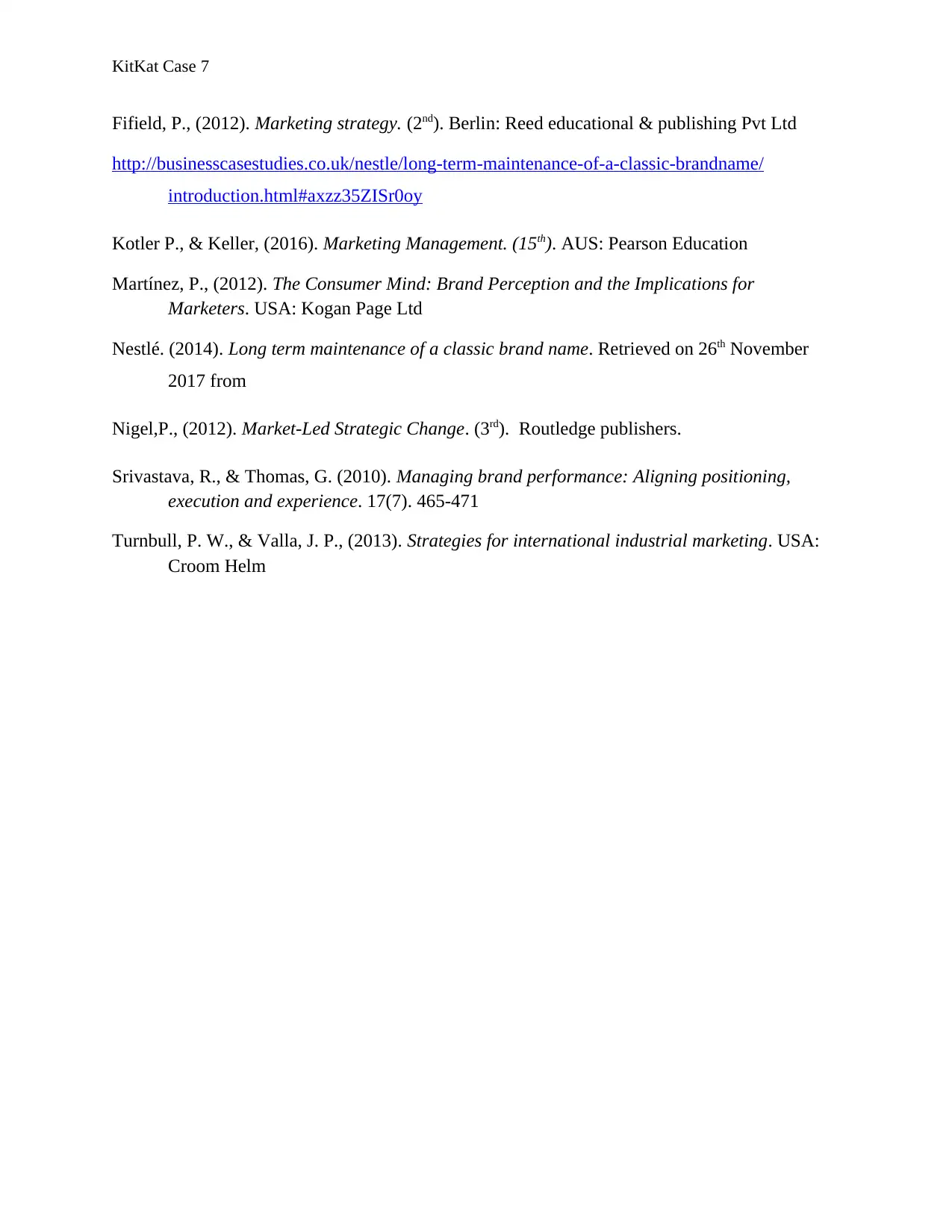
KitKat Case 7
Fifield, P., (2012). Marketing strategy. (2nd). Berlin: Reed educational & publishing Pvt Ltd
http://businesscasestudies.co.uk/nestle/long-term-maintenance-of-a-classic-brandname/
introduction.html#axzz35ZISr0oy
Kotler P., & Keller, (2016). Marketing Management. (15th). AUS: Pearson Education
Martínez, P., (2012). The Consumer Mind: Brand Perception and the Implications for
Marketers. USA: Kogan Page Ltd
Nestlé. (2014). Long term maintenance of a classic brand name. Retrieved on 26th November
2017 from
Nigel,P., (2012). Market-Led Strategic Change. (3rd). Routledge publishers.
Srivastava, R., & Thomas, G. (2010). Managing brand performance: Aligning positioning,
execution and experience. 17(7). 465-471
Turnbull, P. W., & Valla, J. P., (2013). Strategies for international industrial marketing. USA:
Croom Helm
Fifield, P., (2012). Marketing strategy. (2nd). Berlin: Reed educational & publishing Pvt Ltd
http://businesscasestudies.co.uk/nestle/long-term-maintenance-of-a-classic-brandname/
introduction.html#axzz35ZISr0oy
Kotler P., & Keller, (2016). Marketing Management. (15th). AUS: Pearson Education
Martínez, P., (2012). The Consumer Mind: Brand Perception and the Implications for
Marketers. USA: Kogan Page Ltd
Nestlé. (2014). Long term maintenance of a classic brand name. Retrieved on 26th November
2017 from
Nigel,P., (2012). Market-Led Strategic Change. (3rd). Routledge publishers.
Srivastava, R., & Thomas, G. (2010). Managing brand performance: Aligning positioning,
execution and experience. 17(7). 465-471
Turnbull, P. W., & Valla, J. P., (2013). Strategies for international industrial marketing. USA:
Croom Helm
1 out of 7
Related Documents
Your All-in-One AI-Powered Toolkit for Academic Success.
+13062052269
info@desklib.com
Available 24*7 on WhatsApp / Email
![[object Object]](/_next/static/media/star-bottom.7253800d.svg)
Unlock your academic potential
Copyright © 2020–2025 A2Z Services. All Rights Reserved. Developed and managed by ZUCOL.





